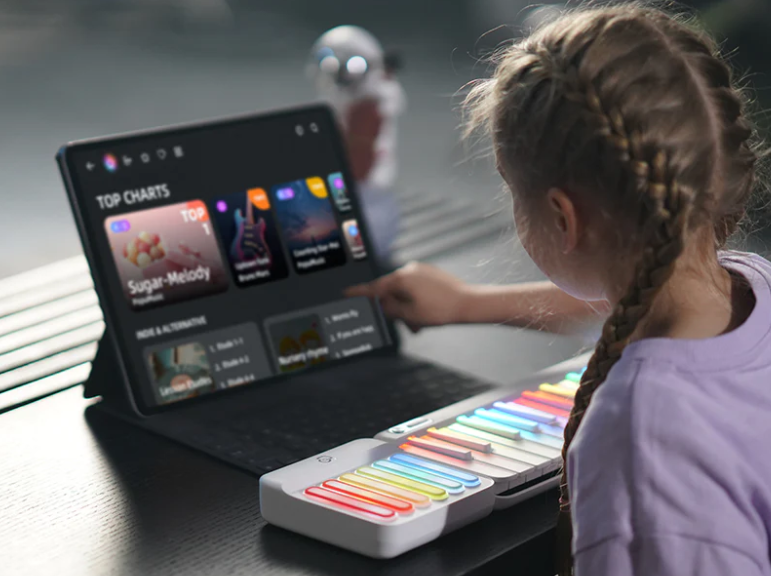
If you're in the market for a piano keyboard in 2025, you're not alone and you're not just choosing between weighted keys or brand names anymore. The newest generation of smart piano brings technology to the forefront, making it easier than ever to learn, play, and even compose music from home.
These instruments go beyond sound they guide your hands with LED lights, sync with learning apps, track your progress, and invite users of all ages and skill levels to enjoy music on their own terms.
Whether you're a total beginner, a creative hobbyist, or a parent looking for a good piano keyboard for your child, smart keyboards offer a more engaging, flexible path into music.
In this article, we’ll compare two of the most talked-about smart keyboards of 2025: PopuMusic and ROLI. Each brings its own strengths to the table from structured learning to creative expression.
We’ll break down their features, highlight key differences, and help you decide which is the best piano keyboard for your needs.
Not all piano keyboards are created equal. While traditional digital pianos are focused purely on sound and key feel, smart keyboards piano bring in a layer of technology designed to support learning, creativity, and ease of use especially for beginners.
LED light-up keys that visually show which notes to play
App integration for learning songs, tracking progress, and guided lessons
Practice tools like slow mode, looping, and tempo adjustment
Bluetooth or USB connectivity for wireless learning or music production
Built-in song libraries and interactive modes for all ages
These features turn the keyboard into a self-teaching tool ideal for users who want to learn independently or who are just starting their musical journey.
Smart keyboards eliminate the steepest hurdles in learning to play piano:
No need to read music right away
Mistakes become part of the process (not a reason to quit)
Practice becomes more like play rewarding, flexible, and fun
For those searching for the best piano keyboards for home learning or family use, smart models are quickly becoming the go-to choice.
When choosing between smart piano keyboards, it helps to see how the top options compare at a glance:
|
Feature |
PopuMusic |
ROLI |
|
Key Action |
Semi‑weighted (mini/full‑size) |
Soft-touch, continuous pressure-sensitive |
|
Learning Tools |
LED guidance, built-in song tutorials |
Minimal built-in lessons; more creative focus |
|
App/Software Use |
Beginner-friendly app, visual feedback features |
ROLI Studio for sound design & DAW integration |
|
Portability |
Modular, battery-powered, lightweight |
Ultra-portable, slim, travel-friendly |
|
Sound & Tone |
App-based with music styles for beginners |
Rich synth tones; touch-responsive expression |
|
Best For |
Beginners, families, structured learners |
Producers, composers, advanced users |
Learning & Guidance: PopuMusic excels at visual step-by-step learning, ideal for beginners and family settings. ROLI, designed for creative exploration, offers less formal instruction and more emphasis on sound manipulation.
Playability: PopuMusic features more traditional, piano-like key feel. ROLI’s pressure-sensitive keys enable dynamic expression and experimental playing styles.
Portability & Setup: Both are portable, but PopuMusic’s modular design offers expandability, while ROLI’s low-profile design prioritizes sleek travel use.
Use Cases:
PopuMusic is best for users who want a solid learning experience, intuitive guidance, and built-in support.
ROLI suits users aiming to create, produce, and experiment with expressive sounds in DAW environments.
Beyond keys and features, how you interact with a smart keyboard plays a huge role in your creative experience. Let’s explore how PopuPiano and ROLI differ in physical layout, button functions, and interface design.
With so many smart instruments emerging, choosing the best piano keyboard as a beginner can feel overwhelming. But the real question isn’t just “what’s best?” it’s “what’s best for how you want to learn?”
If your goal is to learn songs, build confidence, and follow a guided path, PopuMusic offers:
LED light key guidance that shows you exactly what to play
Built-in song libraries so you can practice real music from day one
An app experience focused on step-by-step tutorials, rhythm games, and visual feedback
Modular design, ideal for kids, teens, and adult beginners
PopuMusic is a great choice for families, hobbyists, and anyone seeking a good piano keyboard that makes learning easy and fun without needing music theory upfront.
ROLI, on the other hand, is better suited to users who:
Already have some piano knowledge
Want to explore sound design and digital production
Prefer a freeform, non-linear learning style
Are more focused on creating music than learning how to play traditional melodies
If you’re a producer or creative artist looking to push boundaries rather than learn structure, ROLI offers more open-ended possibilities.
PopuPiano is designed to be visually clean and intuitive, especially for beginners. Most of the keyboard’s deeper functionality is accessed via its companion app.
Physical Controls on the Device:
Power Button (long press to activate Bluetooth)
Chord Pad Toggle – switches between chord learning and scale modes
Octave Shift Buttons – manually shift note range when in compact mode
Function Key – used in combination to activate LED calibration, MIDI mode, or connection reset
User Interface:
Most controls are done through the PopuMusic App, which includes:
Song tutorials
Rhythm games
LED brightness control
Tempo & playback adjustment
LED feedback appears directly on the keys—eliminating the need for an LCD screen
Ideal For:
Learners who prefer guided experiences over button-heavy menus
Kids or adults who want fewer distractions and cleaner UI
ROLI reimagines physical interaction by minimizing traditional buttons and embracing gesture and pressure.
Physical Controls:
Almost buttonless by design—uses software or gestures
Touch-sensitive Brightkey keys allow:
Polyphonic aftertouch
Pitch bend
Glide and vibrato via vertical/horizontal pressure
Optional modular snap-on Block controllers can add faders, encoders, or additional key sets
User Interface:
No screen or built-in buttons—everything is controlled via:
ROLI Studio app for patch changes, modulation, or DAW mapping
Custom software overlays for different music workflows
Loop Block or Lightpad Block for extended control
Ideal For:
Intermediate to advanced users who prefer software-first instruments
Musicians looking for maximum expressive input with minimal physical clutter
Let’s compare the core price structures of PopuPiano and ROLI, including optional accessories and what’s included in the box.
Base Kit (approx. $499):
25-key smart keyboard + LED chord pad
USB-C charging cable
Access to the PopuMusic app (no subscription required)
Carrying case included (in some bundles)
No screen, but app handles visuals and features
Optional Expansion Pack ($239):
Add-on 36 keys for full 61-key setup
Magnetic connection to extend note range
Still guided by the original app/LED system
Good Value For:
Budget-conscious users who want smart features without monthly fees
Families looking for a long-term learning tool
ROLI Piano M (412$):
49 soft-touch keys
Built-in Bluetooth, USB-C
No case included
Must subscribe to ROLI Play or LUMI app for full access (freemium model)
Add-Ons (Modular):
Snap-on Blocks (Lightpad, Loop Block): $80–$150 each
Hard case: sold separately
Full access to sound packs and learning modules often requires paid subscription (monthly/yearly)
Best For:
Creators who are comfortable with a software ecosystem
Producers who value gesture-based expression over classic piano feel
While PopuMusic and ROLI are two of the most innovative smart options this year, there are other good piano keyboards worth considering especially for specific use cases like affordability, traditional play, or simple learning environments.
Ultra-compact and kid-friendly
37 mini keys with basic tones and rhythm patterns
Built-in lesson features and song library
Ideal for early learners or first-time players
Not app-connected, but simple and reliable
Sleek, minimalist design
61 full-size keys with velocity sensitivity
Quality built-in sounds, lightweight frame
Perfect for casual home play and visual appeal
Lacks LED guidance, but intuitive for self-guided practice
61 keys, hundreds of built-in tones and rhythms
Comes with stand, headphones, bench, and microphone
Onboard lesson mode included
Excellent value for families looking to start with everything in one box
88 semi-weighted keys with Bluetooth support
Compact and battery-powered
Pairs well with learning apps and mobile devices
Great for those who want full-range keys without the size of a digital piano
No many of the best piano keyboards for beginners come with 49, 61, or 76 keys. These sizes are lighter, more affordable, and perfect for learning melody, chords, and basic songs. You can always upgrade later if you want to explore full-range classical pieces.
A digital piano aims to replicate the acoustic piano’s sound and feel. A smart keyboard piano, on the other hand, includes interactive learning features like light-up keys, app connectivity, and real-time feedback. It’s more beginner-friendly and geared toward self-guided learning.
Yes! Many smart keyboards come with step-by-step lessons, song tutorials, and built-in feedback. For many learners especially kids and hobbyists it’s a great way to start playing right away without formal lessons.
Absolutely. Many models are designed for multi-age learning, making them great for both kids and adults. Whether you’re picking it up as a hobby or revisiting music after a long break, smart keyboards support every stage of the journey.
Several good piano keyboards fall into this price range. PopuMusic, Alesis Harmony 61, and Casio CT-S1 are all popular options depending on your needs. Prioritize features like touch-sensitive keys, app support, and a learning-friendly interface.
In 2025, learning piano no longer means rigid lessons, expensive tutors, or memorizing theory before you play your first note. Thanks to advances in technology, smart piano keyboards are changing the way people of all ages interact with music making it more intuitive, flexible, and fun.
Whether you're choosing a structured, visual learning experience like PopuMusic or a more experimental creative tool like ROLI, today’s options offer something for everyone.
From good piano keyboards for beginners to more expressive setups for advanced users, the focus is no longer just on sound it’s on the experience of learning and enjoying music at home.
For families, hobbyists, students, or adult beginners, smart keyboards open the door to a lifelong skill in a way that’s low-pressure, interactive, and accessible.
Read more

How Hard Is It for Adult Beginners to Learn Piano? 5 Smart‑Keyboard Fixes
If you’ve ever thought, “I wish I learned piano when I was younger,” you’re not alone. Many adults feel like they’ve missed their chance to learn, worrying that it’s too hard to pick up a new skill...

How Many Strings Does a Guitar Have? A Beginner’s Guide to Modern & Smart Guitars
If you’ve ever picked up a guitar or thought about learning you've probably asked:“How many strings does a guitar have?” At first glance, the answer seems simple. Most people know the standard guit...